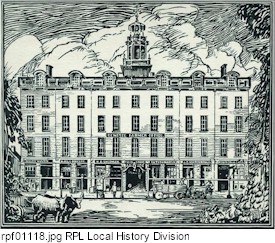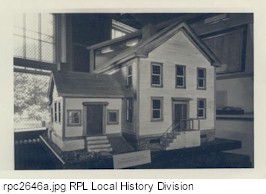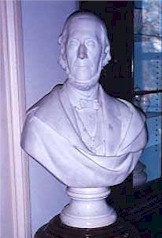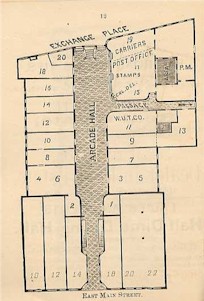
The Reynolds Arcade
Often described as a city within a city, the Reynolds Arcade could be considered Rochester’s first substantial commercial building. The construction of this monumental building was begun in 1828 and was the realization of the dream of Abelard Reynolds.
|
 |
A portrait of Abelard Reynolds and a model showing his first home, which was built in 1812.
Abelard Reynolds (1785 – 1878) was one of the pioneer settlers of the city of Rochester. In 1812 he purchased lots on the north side of what became East Main Street (just east of State Street and the Four Corners intersection). He had a house built there and in 1813 he moved his family in. Reynolds was a valuable member of the newly formed community. He was a saddle-maker, a tavern-keeper and a store-owner. Colonel Nathaniel Rochester appointed him first postmaster in 1812 and Reynolds operated the post office out of his home.
The population of the settlement (Rochester was not officially incorporated as a city until 1834) rapidly grew. By 1828 Abelard felt that Rochester was ready for his Reynolds Arcade. His 1812 home was moved from its site to make room for the new building. The construction of the Arcade was a monumental undertaking. At the start of the project in 1828 most Rochestarians were doubtful that Reynold’s project would succeed. However, Reynolds was a very determined man who proceeded despite a lack of support. One year and $30,000 later, those who had questioned and ridiculed the project now found the immense multi-storied building a great source of pride.
An 1877 photograph of the Arcade’s interior.
The brick-built Arcade originally fronted 99 feet on Main Street, was 56 feet deep and had 86 rooms and 14 cellars. In their article entitled "From Books to Multimedia" Joseph and Robert Barnes wrote a description of the building:
The Reynolds Arcade featured an ingenious design like that of a twentieth century enclosed shopping mall. The arcade proper was a lofty skylighted corridor of generous proportions which divided the building through the middle. Shops and offices opened onto the corridor at ground level and at a second balconied gallery level. |
Near the entrance to the Arcade stood grand murals of the Niagara Falls. A massive clock hung on the south wall surrounded by the busts of Abelard Reynolds and his sons William and Mortimer, who each operated the Arcade for a time. A large fountain sat in the center of the ground floor. Buckets were suspended on the walls ready to be used in case of fire. As soon as the Arcade was finished tenants flocked in. Additions were built in 1838, 1842 and 1862.

A close-up of the bust of Abelard Reynolds (right) which was put on display at the Rochester Historical Society.
Abelard Reynolds’ building was an immediate and lasting success. The Reynolds Arcade stood for over 100 years playing an important role in Rochester’s history. Many of the building’s landmark tenants and events will never be forgotten. The Arcade housed the post office from 1829 – 1891. It was the first home of the Reynolds Library. The Western Union Telegraph Company started there. Rochester’s famous optical company, Bausch & Lomb, began in a small shop in the Arcade. William Reynolds started a seed store there that became the basis for the Ellwanger & Barry Nursery Company, which helped Rochester earn the name Flower City. George B. Selden worked in the Arcade and it was there that he came up with the plans for the first practical gasoline engine. Thomas Edison even spent a night in the Arcade working on his quadruplex telegraphic system. George Eastman had his first job there, Daniel Webster made a famous speech from the Arcade balcony, the first telephone in the city was demonstrated there and Rochester’s first mayor, Jonathan Child, was inaugurated there in 1834.
A general view of the Arcade interior in 1877.
In the "Illustrated Guide to the Reynolds Arcade" published circa 1885 George H. Harris, Superintendent of the Arcade, said of the building:
In all Rochester there is no place so rich in historic memories as the site of Reynolds Arcade, and there is not a room in the building without its special history. Many of the young tenants of an early day have since become distinguished men of the State and Nation, and every citizen of Rochester has been more or less associated with the Arcade and its interests. For nearly three-score years the currents of all local business have concentrated in and flowed from this grand old building with the regularity of tide and ebb, and despite all counter attractions it still remains the active business centre of our great city, containing the Post Office, [telegraph offices] and representing among its three hundred and fifty occupants nearly every profession and line of business. |
|
 |
A rear view of the Arcade and a diagram of the first floor, circa 1885 (from "Illustrated Guide to Reynolds Arcade")
Throughout its long life the Reynolds Arcade never had a shortage of tenants. It changed very little over the years, except for the addition of ever-increasing modern conveniences such as electricity. The building did eventually become outdated, however, and many people saw it as a firetrap. The Arcade, which at the time of its construction had been considered the largest, grandest and most expensive building west of Albany, was razed in May of 1932. Various former occupants and local historians kept pieces of the Arcade, such as portions of the wooden railings, as mementos of the historic building.
The original Reynolds Arcade (left) in 1932 and the new Reynolds Arcade (right) in 1981.
A modern Art Deco style office building was built in the old Arcade’s place in 1932/33. The new structure was also named Reynolds Arcade in remembrance of the former building and a plaque (praising the original Arcade) was placed in its lobby so that new visitors would not forget about the site’s history. However, Rochester’s numerous fond memories of life in the old Arcade would ensure that it would not be forgotten. The first Reynolds Arcade is perhaps best recalled in the following reminiscence by Rochesterian John Rothwell Slater:
Along its little galleries were shops, factories, offices, studios, clubs, barbers and tailors, dentists and jewelers and bootblacks – a little of everything. You could buy a suit, pawn a watch, see a doctor, meet a friend, escape a bore, borrow money, sell a bond, send a telegram, read a paper, get a shine, eat a meal, play a game of chess and buy flowers for the lady; or you could hire a desk and wait for customers to come pouring in. Leisure and haste were joint tenants. |
For Further Reading
Barnes, Joseph W. and Robert W. "From Books to Multimedia," Rochester History Vol. XXXVI No. 4 (1974).
Croughton, Amy Hanmer. "Historic Reynolds Arcade," Rochester Historical Society Publication Fund Series Volume VIII. Rochester: Canfield & Tack Inc., 1929.
Illustrated Guide to Reynolds Arcade. Rochester: Harris & Foxwell, 1885(?).
Slater, John Rothwell. "Rochester Forty Years Ago," Rochester Historical Society Publication Fund Series Volume XX. Rochester: DuBois Press, 1942.
Send comments to Webmaster
Copyright 2021 Monroe County (NY) Library System
115 South Ave., Rochester, NY 14604